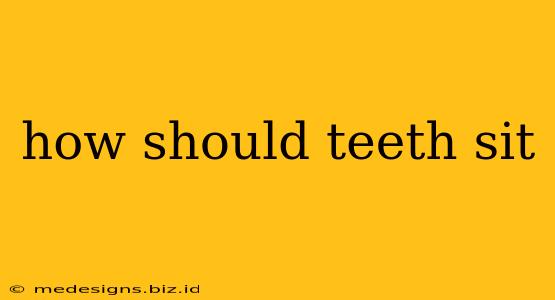Having a healthy, beautiful smile is more than just aesthetics; it's crucial for your overall oral health and well-being. Understanding how your teeth should sit is the first step towards achieving and maintaining optimal dental health. This guide will delve into the intricacies of proper bite alignment, explaining what to look for and when to seek professional help.
Understanding Your Bite: The Basics
Your bite, or occlusion, refers to the way your upper and lower teeth come together. A proper bite is essential for efficient chewing, clear speech, and the prevention of various dental problems. There are several key aspects to consider:
1. Overbite: The Vertical Relationship
An overbite describes the vertical overlap of your upper front teeth over your lower front teeth. A slight overbite is generally considered normal. However, a significant overbite (where the upper teeth excessively cover the lower teeth) or an underbite (where the lower teeth protrude beyond the upper teeth) can lead to problems with chewing, jaw pain (TMJ disorders), and wear and tear on the teeth.
2. Overjet: The Horizontal Relationship
Overjet refers to the horizontal projection of the upper teeth beyond the lower teeth. A slight overjet is often considered normal, but an excessive overjet can impact your bite and aesthetics.
3. Crossbite: Misaligned Jaws
A crossbite occurs when some or all of your upper teeth bite inside your lower teeth, rather than outside. This is often a sign of underlying jaw misalignment and may require orthodontic intervention.
4. Open Bite: Gaps Between Teeth
An open bite is characterized by a gap between your upper and lower front teeth when you bite down. This can hinder proper chewing and speech and may be caused by various factors, including thumb sucking or tongue thrusting.
Ideal Bite Alignment: What to Look For
A healthy bite typically exhibits:
- Even Contact: When you bite down, your upper and lower teeth should make even contact across most of their surfaces.
- Proper Jaw Alignment: Your upper and lower jaws should align correctly, with minimal strain or discomfort.
- No Significant Gaps or Overlaps: There should be no significant gaps between your teeth or excessive overlaps of the upper teeth over the lower teeth.
- Comfortable Chewing and Speech: You should be able to chew food efficiently and speak clearly without any difficulty.
When to See a Dentist or Orthodontist
If you notice any of the following, it's crucial to consult with a dentist or orthodontist:
- Pain or Discomfort: Persistent jaw pain, headaches, or discomfort when chewing.
- Difficulty Chewing or Speaking: Problems with chewing food effectively or speaking clearly.
- Noticeable Misalignment: Significant overbite, underbite, crossbite, or open bite.
- Excessive Tooth Wear: Premature wear or damage to your teeth.
- Concerns About Your Smile: If you're concerned about the appearance of your teeth and bite.
Early intervention is key. Addressing bite problems early can often prevent more significant issues from developing in the future.
Maintaining a Healthy Bite
Beyond professional intervention, maintaining a healthy bite also involves:
- Regular Dental Checkups: Routine checkups allow your dentist to monitor your bite and address any potential problems early on.
- Proper Oral Hygiene: Maintaining good oral hygiene through regular brushing and flossing helps prevent dental problems that can impact your bite.
- Avoiding Harmful Habits: Stop habits such as thumb sucking, nail biting, or bruxism (teeth grinding), which can negatively affect your bite.
By understanding how your teeth should sit, and seeking professional guidance when necessary, you can ensure a healthy, functional, and beautiful smile for years to come. Remember, a healthy bite is more than just aesthetics—it's integral to your overall oral health and well-being.
